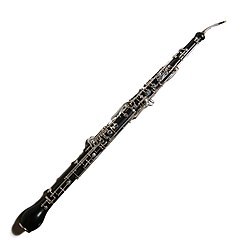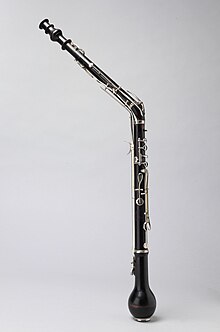 | |
| Woodwind instrument | |
|---|---|
| Classification | |
| Hornbostel–Sachs classification | 422.112-71 (Double reed aerophone with keys) |
| Developed | about 1720 from the oboe da caccia |
| Playing range | |
 Written pitch, notated in F, sounds a perfect fifth lower
 Sounding pitch | |
| Related instruments | |
| Part of a series on |
| Musical instruments |
|---|
The cor anglais (UK: /ˌkɔːr ˈɒŋɡleɪ/, US: /- ɑːŋˈɡleɪ/[1][2] or original French: [kɔʁ ɑ̃ɡlɛ];[3] plural: cors anglais), or English horn (in North American English), is a double-reed woodwind instrument in the oboe family. It is approximately one and a half times the length of an oboe, making it essentially an alto oboe in F.
The cor anglais is a transposing instrument pitched in F, a perfect fifth lower than the oboe (a C instrument).[4] This means that music for the cor anglais is written a perfect fifth higher than the instrument sounds. The fingering and playing technique used for the cor anglais are essentially the same as those of the oboe, and oboists typically double on the cor anglais when required. The cor anglais normally lacks the lowest B♭ key found on most oboes, and so its sounding range stretches from E3 (written B♮) below middle C to C6 two octaves above middle C. Some versions being made today have a Low B♭ key to extend the range down one more note to sounding E♭3.
The pear-shaped bell (called Liebesfuß) of the cor anglais gives it a more covered timbre than the oboe, closer in tonal quality to the oboe d'amore. Whereas the oboe is the soprano instrument of the oboe family, the cor anglais is generally regarded as the alto member of the family, and the oboe d'amore—pitched between the two in the key of A—as the mezzo-soprano member.[5] The cor anglais is perceived to have a more mellow and plaintive tone than the oboe.[6] The difference in sound results primarily from a wider reed and a conical bore that expands over a greater distance than the oboe's; although darker in tone and lower in pitch than the oboe, its sound is distinct from (though naturally blends with) the sound of the bassoon family. Its appearance differs from the oboe in that the instrument is notably longer, the reed is attached to a slightly curved metal tube called the bocal, or crook, and the bell has a bulbous shape ("Liebesfuß").
The cor anglais is usually notated in the treble clef, a perfect fifth higher than sounding pitch. Alto clef written at sounding pitch is occasionally used, even by as late a composer as Sergei Prokofiev. In late-18th- and early-19th-century Italy, where the instrument was often played by bassoonists instead of oboists, it was notated in the bass clef an octave below sounding pitch (as found in Rossini's Overture to William Tell). French operatic composers up to Fromental Halévy notated the instrument at sounding pitch in the mezzo-soprano clef, which enabled the player to read the part as if it were in the treble clef.[5]
Although the instrument usually descends only to (written) low B♮, continental instruments with an extension to low B♭ (sounding E♭) have existed since early in the 19th century.[7] Examples of works requiring this note (while acknowledging its exceptional nature) include Arnold Schoenberg's Gurre-Lieder, Gustav Mahler's Das Lied von der Erde, Heitor Villa-Lobos's Chôros No. 6, and Karlheinz Stockhausen's Zeitmaße. Antonín Dvořák, in his Scherzo capriccioso, even writes for the cor anglais down to low A, though it seems unlikely that such an extension ever existed.[8]
Reeds used to play the cor anglais are similar to those used for an oboe, consisting of a piece of cane folded in two. While the cane on an oboe reed is mounted on a small metal tube (the staple) partially covered in cork, there is no such cork on a cor anglais reed, which fits directly on the bocal. The cane part of the reed is wider and longer than that of the oboe. Unlike American-style oboe reeds, cor anglais reeds typically have some wire at the base, approximately 5 mm (0.20 in) from the top of the string used to attach the cane to the staple. This wire serves to hold the two blades of cane together and stabilize tone and pitch.
Perhaps the best-known makers of modern cors anglais are the French firms of F. Lorée, Marigaux, and Rigoutat, the British firm of T. W. Howarth, and the American firm Fox Products. Instruments from smaller makers, such as A. Laubin, are also sought after. Instruments are usually made from African blackwood (aka Grenadilla), although some makers offer instruments in a choice of alternative woods as well, such as cocobolo (Howarth) or violet wood (Lorée), which are said to alter the voice of the cor anglais slightly, producing a more mellow sound. Fox has recently made some instruments in plastic resin and maple, the latter being the wood traditionally used for bassoons.

The term cor anglais is French for English horn, but the instrument is neither from England nor related to the various conical-bore brass instruments called "horns", such as the French horn, the natural horn, the post horn, or the tenor horn. The instrument originated in Silesia about 1720 when a bulb bell was fitted to a curved oboe da caccia-type body by the Weigel family of Breslau. The two-keyed, open-belled, straight tenor oboe (French taille de hautbois, "tenor oboe"), and more particularly the flare-belled oboe da caccia, resembled the horns played by angels in religious images of the Middle Ages. This gave rise in German-speaking central Europe to the Middle High German name engellisches Horn, meaning angelic horn. Because engellisch also meant English in the vernacular of the time, the "angelic horn" became the "English horn". In the absence of any better alternative, the curved, bulb-belled tenor oboe then retained the name even after the oboe da caccia fell into disuse around 1760.[9] The name first appeared regularly in Italian, German, and Austrian scores from 1749 on, usually in the Italian form corno inglese.[10]
The earliest known orchestral part specifically for the instrument is in the Vienna version of Niccolò Jommelli's opera Ezio dating from 1749,[11] where it was given the Italian name corno inglese.[12] Gluck and Haydn followed suit in the 1750s,[13] and the first English horn concertos were written in the 1770s. The Schwarzenberg Wind Harmonie of 1771 employed 2 cors anglais as well as 2 oboes, 2 bassoons and 2 horns. Johan Went was first cor anglais and Ignaz Teimer (father of the Teimer brothers) was second cor anglais. The first oboe trios were composed by Johan Went for the Teimer brothers. The oboe and cor anglais writing in these original Bohemian/Viennese trios by Johan Went and Joseph Triebensee are notable as written by oboists for oboists and include some early examples of florid virtuosic writing for the cor anglais, paving the way for similar writing to come. In 1796 Johann and Franz Teimer died. The first recorded performance of an oboe trio was 1793 (which Beethoven attended). While the Teimer brothers performed in Vienna and environs, over 20 oboe trios were composed. Phillip Teimer continued to play the cor anglais in Schikaneder's opera house in Vienna. He also sang some roles with the company due to his sonorous bass voice. Many cor anglais parts were specially written for him by Stengel, Süssmayr, Paer, Winter, Weigl, Eberl, Eybler, Salieri, Hummel, Schacht and Fisher.[14]
Considering the name "cor anglais", it is ironic that the instrument was not regularly used in France before about 1800 or in England before the 1830s.[13] It is mentioned in the Penny Cyclopedia from 1838 as "The English Horn, or Corno Inglese, is a deeper-toned oboe [...]", while the first identified printed use of the term cor anglais in English was in 1870.[15] In the UK the instrument is colloquially generally referred to as the "cor".[5] The local equivalent for "English horn" is used in most other European languages, while a few languages use their equivalent of "alto oboe".
Due to the earlier bowed or angular forms it took, the suggestion has been made that anglais might be a corruption of Middle French anglé (angular, or bent at an angle, angulaire in modern French),[16] but this has been rejected on grounds that there is no evidence of the term cor anglé before it was offered as a possible origin of anglais in the late 19th century.[17]
|
Main article: List of concertos for English horn |
Until the 20th century, there were few solo pieces for the instrument with a large ensemble (such as orchestra or concert band). Important examples of such concertos and concertante works are:
† Though concertante in nature, these are just orchestral works featuring extensive solos, with the player seated within the orchestra
Better known chamber music for English horn includes:
The English horn's timbre makes it well suited to the performance of expressive, melancholic solos in orchestral works (including film scores) as well as operas. Famous examples are:
